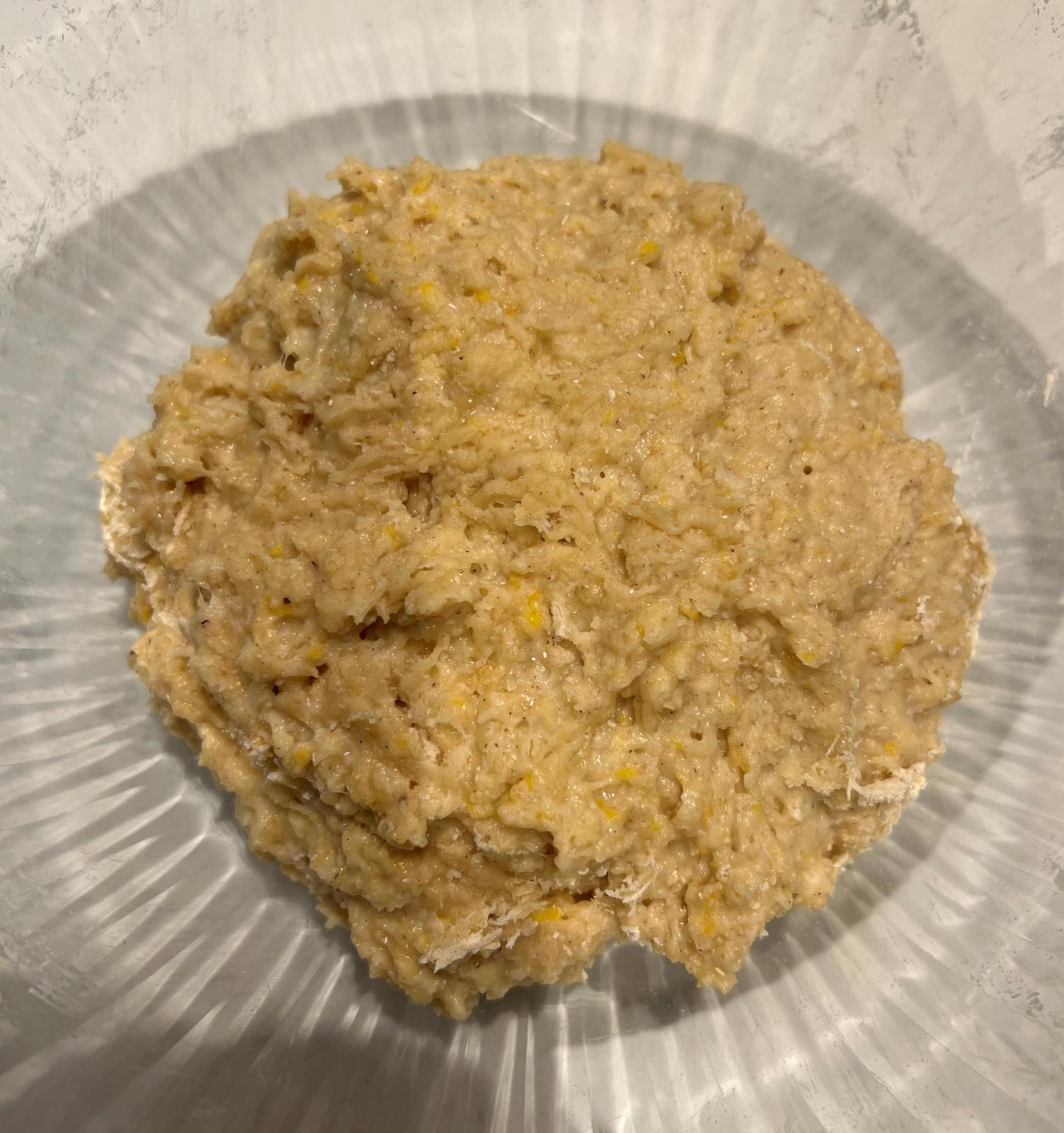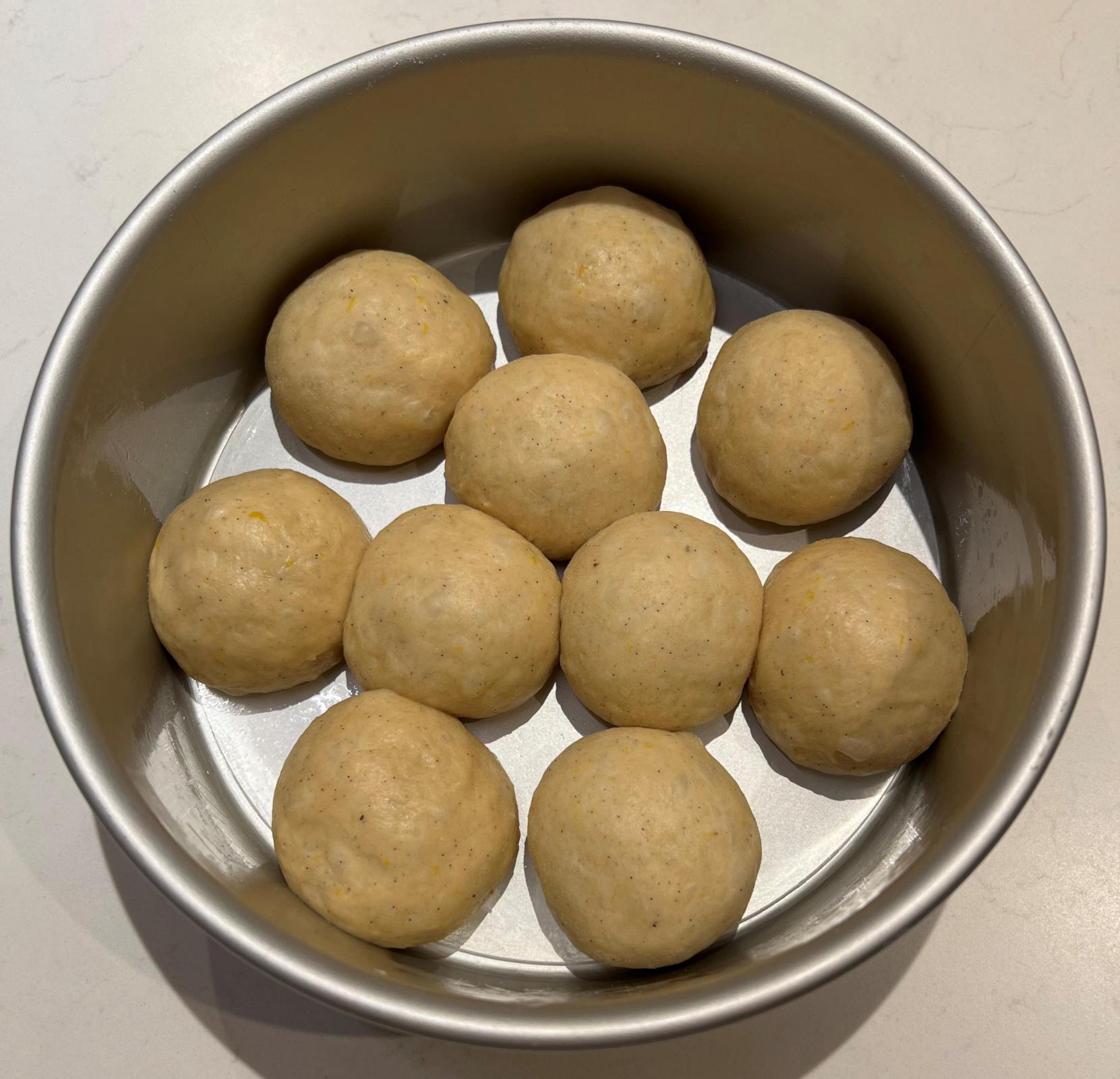Take 1 - Following(?) the recipe
This did not end up being the greatest example of following a recipe as written, but that was the guiding intent.
Changes to formula:
- Reduce sugar to 15.%
- Increase salt from 1.0% to 1.5%
- Use non-osmotolerant yeast (SAF instant red) and reduce to 1.0%
- Replace 5.0% instant potato flakes with 4.0% potato starch
- Substitute 50.% milk for 5.0% dry milk, omitting water
- Replace citrus extracts with citrus zest
- Replace vanilla extract with vanilla sugar
I reduced the sugar. 28% is a mind-boggling amount of sugar.
I only had SAF instant red yeast on hand and used that. Since I reduced the sugar, I also reduced the yeast.
The remaining substitutions are for my convenience. I believe the instant potato flakes, nonfat milk powder, and extracts are also tailored to the convenience of the recipe writer and not integral to the formula. Tapioca starch or cornstarch should also work.
Changes to process:
- Incorporate creamed butter/sugar mixture at the end of mixing
This recipe is optimised for the mechanical method. I did think about following the original order of butter/sugar->flour/yeast->liquids->remaining flour. But when hand-kneading enriched doughs, one is generally working against the clock to achieve sufficient gluten development before the yeast gets going. Unfortunately there are no explanatory notes to the original text. Most probably the reason for adding 40% flour directly to the butter is to 'shorten' the dough, resulting in a less chewy and more tender texture. But is this really necessary without the machine? In the end I went with conventional logic.
<!--break-->
Baking Log:
1) Whisk together milk and potato starch in saucepan. Cook until thickened. Cover and set aside to cool.
2) Combine flour, salt, yeast, nutmeg, and lemon zest. Add eggs and potato/milk roux. Weigh the latter and add water to compensate for any lost weight. Mix until dough just forms.

3) Rest dough for 10 minutes. Meanwhile, cream together butter and sugar with a wooden spoon. [Note: In theory butter is best creamed within its plastic range, ~18-20 degrees C.]
4) Turn dough out onto counter and knead for 10 minutes. Incorporate butter/sugar mixture in 3-4 additions over the next 5 minutes. Carry on kneading for another 10 minutes for a total of 25 minutes. Dough after kneading:

Set aside to ferment. Ambient temperature 23-24 degrees C.
5) End first fermentation after 2 hours 20 minutes (2 hours 55 min after initial mixing). Divide into 10 pieces and shape into rounds. Arrange in 20 cm round tin.

Set aside to ferment. Ambient temperature 23-24 C.
7) Preheat oven to 170 C convection.
Dough at end of second proof:

8) Egg wash thinly. Bake for 25 minutes, tenting with foil after 10 minutes. Internal temperature 94 C.




Notes on process:
- Dough was initially (before adding butter/sugar) a pain to knead. The hydration is not quite high enough for slap and fold, but too high for conventional kneading.
- Kneading could have gone on for another 5-10 min. I only stopped because the dough was obviously fermenting under my hands.
Tasting/appearance notes:
- Good colour, excellent oven spring.
- Aroma exemplary
- Texture good, soft and shreddable if burgeoning on just so ever slightly dry
- Taste very good. 15% sugar is plenty sweet. 1% nutmeg is absolutely necessary. Perhaps the taste lacks some complexity, but I'm really nitpicking here.
Changes for next time:
- This time I tried to honour the original recipe by creaming the butter and sugar and incorporating halfway through kneading. It was a novel experience and I'm glad I tried it. But having tried it, I can sense this is not optimal. Instead, after mixing and briefly resting the dough to let the flour hydrate, incorporate the sugar before kneading. This should a) make the dough more fluid for easier kneading, and b) slow down yeast activity. When gluten is well-developed, then incorporate butter. Plan to knead for 30-35 minutes in total.
- Decrease baking time by 3-4 minutes. Colour is not a reliable indicator of doneness. Aim for 88 C internal temperature.
- Add 0.5 g mace
- Add the zest of half an orange
- Divide into 11 buns
Final thoughts:
The most special aspect of this bread is the nutmeg-citrus-vanilla combination. Reminds me of fiori di Sicilia. I strongly recommend not omitting any of the flavourings. If using pre-ground nutmeg then increase the amount. The texture was in every way satisfactory if not mind-blowing. But it's difficult for me to comment on the texture per se having a) substantially reduced the sugar, and b) not followed the recipe instructions. If anyone tries the recipe as written but by hand I'd be very interested in the results.
2 hours 20 min at 23-24 degrees C for first fermentation was a result of my schedule. The dough was definitely ready before that.
If/when I get some SAF instant gold yeast it would be interesting to see what impact that makes.
Actually, it's odd that this bread is apparently prone to dryness and quick staling. The roux and sugar should effectively counteract both.
Recipe:
Total dough weight 548 g
Total flour weight 250 g
Hydration 68.%
10 buns in a 20 cm round tin
125 g milk (50.%)
10 g potato starch (4.0%)
250 g strong white flour
135 g potato-milk roux
73 g eggs, about one and a half (29.%); reserve remainder for egg wash
3.8 g salt (1.5%)
2.5 g yeast, SAF instant red (1.0%)
2.5 g nutmeg, grated (1.0%); about half a nutmeg
zest of one lemon
38 g butter (15.%)
25 g caster sugar
13 g vanilla sugar (15.% in total)